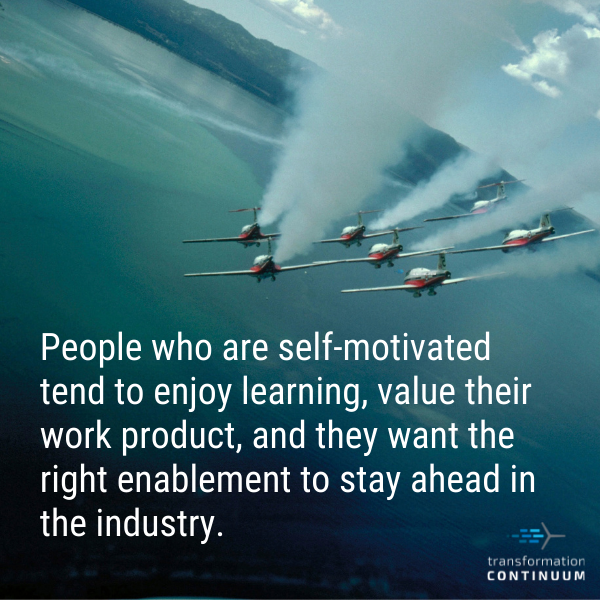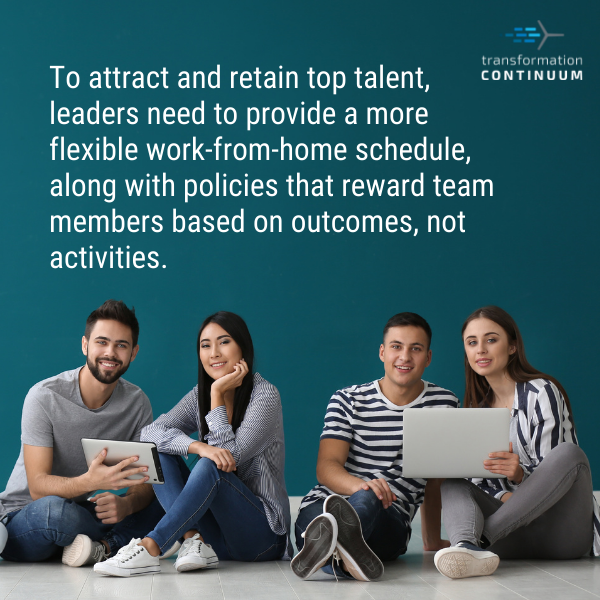Businesses require a flexible workforce today, with business agility, innovation and collaboration the top priorities. However, to set their workforce up for success and achieve these priorities, businesses need to figure out new ways to improve their employee satisfaction and ingenuity.
Businesses require a flexible workforce today, with business agility, innovation and collaboration the top priorities. However, to set their workforce up for success and achieve these priorities, businesses need to figure out new ways to improve their employee satisfaction and ingenuity.
So, how can businesses attract and retain top talent that helps the organization be agile and innovative within the evolving work environment? Let’s examine the top four things research is showing businesses must address if they’re going to maximize collaboration, relevance and influence:
1. Look for people with specific values.
1. Look for people with specific values.
Business leaders need to target self-motivated people if they want to accommodate for the work-from-home culture Covid-19 created. In my experience, people who are self-motivated tend to enjoy learning, value their work product and want the right tools to stay ahead in the industry. I’ve found these individuals also often seek new opportunities to learn, have high expectations for their employers and tend to be top performers (especially when in the right environment). That’s why business leaders must enable a productive and collaborative workspace, whether onsite or remote, to foster successful teams (but more on that later).

Fortunately, you instantly know if your remote team is working based on their work product, their questions and their behavior. But, hiring can be challenging because you may not have previously worked with the potential team member to know their performance, communication and collaboration practices.
When looking for talent, look for self-motivated people who are driven by accomplishment, creating value and exceeding expectation. This will be obvious by their past achievements in previous job roles and their personal life.
2. Use technology to enable better collaboration, innovation and production
2. Use technology to enable better collaboration, innovation and production
As the CEO of an end-to-end, go-to-market solutions accelerator, I’ve seen that collaborating in a remote or hybrid team is extremely difficult. In a recent conversation with the innovation manager of a large candy company, they spoke to me about the drawbacks of remote collaboration. They detailed how their once-streamlined innovation process has been significantly disrupted with factory delays, overnight shipping of soon-to-market candies and less-than-productive workshops.
Could some of these issues be the result of team members who lack the attributes discussed in the first point? Possibly. But from hearing about the issues across factories, shipping and collaboration, I believe these problems are more the result of needing to digitally transform. The company needed the help of technology to enable its hybrid workforce to be successful.
Top-performing team members don’t want to be held back by technology.
Instead, they want to be empowered by it.
Top-performing team members don’t want to be held back by technology. Instead, they want to be empowered by it. You might initially attract the right talent, but without the proper technology, you won’t be able to benefit from their full potential. You probably won’t be able to retain them, either.
So if you’re looking to digitally transform on your own, keep in mind that a common roadblock organizations run into is becoming too bottlenecked. This ultimately slows the speed of innovation and often derails execution altogether. As a best practice, it’s important to set meaningful objectives and targets to meet your objective. Moreover, work together regularly to collaborate, confirm milestones are being met and set ongoing expectations. Don’t be afraid to outsource strategically, too, if you need help building and scaling your vision.
3. Have a flexible work-from-home policy that rewards people based on action, not just hours.
3. Have a flexible work-from-home policy that rewards people based on action, not just hours.
As a leader, hiring and building teams are some of your top priorities. Building collaborative, efficient and innovative teams is a necessity. It always has been.
With home demands more intensive and complex than before, people need a different work schedule than our traditional nine-to-five. Moreover, where people work has been proven to be less important (in most cases) than what they produce.

In a recent case study on the impact of productivity for remote workers, 94% of employers found the productivity of remote teams is the same or even higher than before the pandemic. Additionally, 83% of employers anticipate having a more flexible work schedule for employees even after the health crisis.
To attract and retain top talent, leaders need to provide a more flexible work-from-home schedule, along with policies that reward team members based on outcomes, not activities.
4. "Fire" your customers who fit the transactional one-and-done profile.
4. "Fire" your customers who fit the transactional one-and-done profile.
Hear me out: For most businesses, we need to reconsider how we look at our customers. More specifically, we need to pivot to a client-based model focused on long-term relationships in which our talented, ambitious, problem-solving teams help clients create and execute solutions. That’s what I’ve seen top performers often want to do: add value and have a purpose.
In my experience, intentionally investing in the needs and longevity of your clients can help lead to better-performing and happier teams, and providing an environment where team members can achieve this can help attract and retain them. There’s a big bonus to your clients, too, so it’s a win-win.
A client-based mindset looks at the needs of their clients differently than they would of customers who fit the “one-and-done” profile. Businesses that relabel their customers to “clients” can make a powerful mind shift.
Businesses with a client-based mindset set the expectation to have longer, more repeatable and meaningful engagements with their clients — engagements that focus not only on their experience but also their bottom line.
Glad you heard me out on that one. Again, it’s not about firing your customers as much as it is about reconsidering how we look at them (and how central they are to our decisions).
The Takeaway
The Takeaway
This is a time that’s abundantly ripe with the opportunity to change the way we go to market, work together and consume. As a leader, the type of talent you want to attract and retain are problem-solvers and go-getters.
Organizations and teams that will thrive — and ultimately help change the world as we know it — will be self-motivated, ambitious, reliable and collaborative. Team members have to innovate and serve better and faster than ever before and do so in an entirely remote or flexible workspace. If leaders want to drive a more transformative organization, they have to focus on attracting and retaining the right people who thrive in an ever-changing environment.
Want more? Contact the Continuum Team to talk about enabling your teams and channel for 2022.

